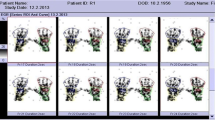Abstract
Technetium-99m sestamibi was used for functional investigation of the muscle perfusion of lower extremities in 35 patients with peripheral vascular disease. The aim was to test what useful information could be obtained by additional imaging of the legs in patients referred for risk stratification with dipyridamole myocardial scanning. Posterior images were acquired over the thighs and calves after postocclusive reactive hyperaemia and at rest. Inter- and intraextremity ratios and differences between the stress and rest data were used for the assessment of abnormal circulation. Arteriography was performed in every case, and surgical procedures or transluminal angioplasty in 31 patients. To estimate diagnostic accuracy, the results of99mTc-sestamibi scintigraphy were compared with those of angiography and the functional consequences of revascularization procedures. The sensitivity and specificity of99mTc-sestamibi scintigraphy were 55% and 25%, respectively, with an overall accuracy of 50%. Apparently methodological error was not responsible for these poor results. Instead, a paradoxically high uptake of the radiopharmaceutical in muscles supplied by significantly stenosed vessels was identified as the main source of both false-negative and false-positive results. This phenomenon resembles the findings of a previous study involving delayed administration of thallium-201 after exercise. In conclusion,99mTc-sestamibi scintigraphy has not proved sufficiently reliable to help in the management strategy for patients with peripheral vascular disease.
Similar content being viewed by others
References
Strauss HW, Karrison K, Pitt B. Thallium-201: noninvasive determination from the regional distribution of cardiac output.J Nucl Med 1977; 18: 1167–1170.
Christenson J, Larsson I, Svensson SE, Westling H. Distribution of intravenously injected thallium-201 in the legs during walking.Eur J Nucl Med 1977; 2: 85–88.
Siegel ME, Siemsen JK. A new noninvasive approach to peripheral disease: thallium-201 leg scans.Am J Roentgenol 1978;131:827–830.
Glass EC, DeNardo GL. Abnormal peripheral distribution of thallium-201 due to arteriosclerosis.Am J Roentgenol 1978; 131:718–720.
Seder JS, Botvinick EH, Rahimtoola SH, Goldstone J, Price DC. Detecting and localizing peripheral arterial disease: assessment of201T1.AJR 1981; 137: 373–380.
Hamanaka D, Odori T, Maeda H, Ishii Y, Hayakawa K, Torizuka K. A quantitative assessment of scintigraphy of the legs using201T1.Eur J Nucl Med 1984; 9: 12–16.
Chevreaud C, Thouvenot P, Lapeyre G, Laurens M-H, Renard C. Thallium-201 muscle scintigraphy: application to the management of patients with arterial occlusive disease.Angiology 1987;38:309–314.
Oshima M, Akanabe H, Sakuma S, Yano T, Nishikimi N, Shionoya S. Quantification of leg muscle perfusion using thallium-201 single photon emission computed tomography.J Nucl Med 1989, 30: 458–465.
Segall GM, Lennon SE, Stevick CD. Exercise whole-body thallium scintigraphy in the diagnosis and evaluation of occlusive arterial disease of legs.J Nucl Med 1990; 31: 1443–1449.
Segall GM, Lang EV, Lennon SE, Stevick CD. Functional imaging of peripheral vascular disease: a comparison between exercise whole-body thallium perfusion imaging and contrast arteriography.J Nucl Med 1992; 33: 1797–1800.
Zocholl G, Benning R, Nagel K, et al. Quantification of blood flow changes in skeletal muscle after revascularization using a99mTc-labelled tracer.Nuklearmedizin 1990; 29: 215–220.
Sayman HB, Urgancioglu I. Muscle perfusion with technetium-MIBI in lower extremity peripheral arterial diseases.J Nucl Med 1991; 32: 1700–1703.
Miles KA, Barber RW Wraight EP, Cooper M, Appleton DS. Leg muscle scintigraphy with 99Tcm-MIBI in the assessment of peripheral vascular (arterial) disease.Nucl Med Commun 1992;13:593–603.
Siegel ME, Giargiana FA, Rhodes BA, White RI, Wagner HN. Effect of reactive hyperemia on the distribution of radioactive microspheres in patients with peripheral vascular disease.Am J Roentgenol 1973; 118: 814–819.
Siegel ME, Stewart CA. Thallium-201 peripheral perfusion scans: feasibility of single-dose, single-day, rest and stress study. AJR 1981; 136: 1179–1183.
Yao JST, Peterson LK, Payne K. Lower limb systolic pressure measurements: technique and clinical applications.Inter Angio 1985; 4: 31–39.
Beales JSM, Adcock FA, Frawley JS, et al. The radiological assessment of disease of profunda femoris artery.Br J Radiol 1971;44:854–859.
Siegel ME, Stewart CA, Kwong P, Sakimura I.201Tl perfusion study of “ischaemic” ulcers of the leg: prognostic ability compared with Doppler ultrasound.Radiology 1982; 143: 233–235.
Ohta T, Matsubara J, Shionoya S. Noninvasive evaluation for the therapeutic effect using thallium-201 in the ischaemic footVasc Surg 1985; 3: 99–106.
Boucher CA, Brewster DC, Darling RC, Okada RD, Strauss HW Pohost GM. Determination of cardiac risk by dipyridamole-thallium imaging before peripheral vascular surgery.N Engl J Med 1985; 312: 389–394.
Younis LT, Aguirre F, Byers S, et al. Perioperative and longterm prognostic value of intravenous dipyridamole thallium scintigraphy in patients with peripheral vascular disease.Am Heart J 1990; 119: 1287–1292.
Novo S, Pinto A, Abrignani MG, et al.201Tl scintigraphy for the simultaneous detection of coronary and peripheral arterial diseases. In: Strano A, Novo S, eds.Advances in vascular pathology 1989. Amsterdam: Elsevier; 1989: 1249–1254.
Burt R, Mullinix F, Schauwecker D, Richmond B. Leg perfusion evaluated by delayed administration of thallium-201.Radiology 1984; 151: 219–224.
Meerdink DJ, Leppo JA. Experimental studies of the physiologic properties of technetium-99m agents: myocardial transport of perfusion imaging agents.Am J Cardiol 1990; 66: 9E-15E.
Author information
Authors and Affiliations
Rights and permissions
About this article
Cite this article
Bajnok, L., Kozlovszky, B., Varga, J. et al. Technetium-99m sestamibi scintigraphy for the assessment of lower extremity ischaemia in peripheral arterial disease. Eur J Nucl Med 21, 1326–1332 (1994). https://doi.org/10.1007/BF02426697
Received:
Revised:
Issue Date:
DOI: https://doi.org/10.1007/BF02426697




